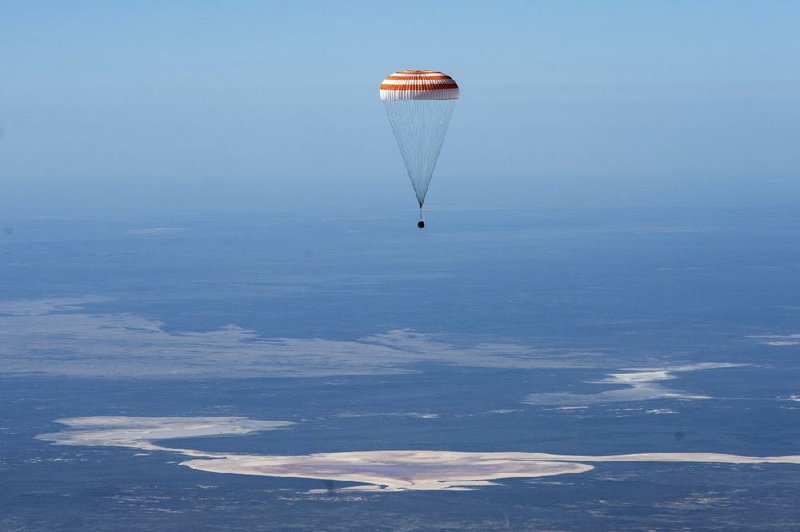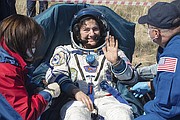It's been nearly 10 years since the last NASA astronauts launched from United States soil -- a long streak that's been compounded by delays and technical challenges.
But now, finally, the space agency on Friday set the date for when it will fly its astronauts from the Florida Space Coast again: May 27.
While the date could change, the announcement marks a significant milestone in NASA's winding journey to regain its human spaceflight wings since it retired the space shuttle in 2011.
This launch will be markedly different from any other in the history of the space agency. Unlike Mercury, Gemini, Apollo or the space shuttle era, the rocket will be owned and operated not by NASA, but by a private company -- SpaceX, the commercial space company founded by Elon Musk.
[Gallery not loading above? Click here for more photos » arkansasonline.com/418nasa/]
For all the company's triumphs, and its experience flying cargo to the International Space Station for NASA, it has never flown a single human being into space, a significant and dangerous challenge. NASA has spent years working with the California-based company to ensure its Falcon 9 rocket and Dragon spacecraft can safely deliver astronauts to orbit. And the flight would be the culmination of years of work, which has at times seen setbacks and delays.
With a successful launch, SpaceX would accomplish an upset over its rival, Boeing, which also is under contract to fly NASA crews to the space station as part of the agency's "commercial crew program."
Boeing's Starliner spacecraft suffered a series of significant setbacks during a test flight without astronauts in December that prevented it from docking with the station and prompted an investigation by NASA. Numerous flaws were uncovered, and Boeing recently agreed to refly the mission without astronauts on board before proceeding to a crewed flight.
SpaceX, meanwhile, last year successfully flew its Dragon to the station, paving the way for a crewed flight.
In an interview with The Washington Post last week, NASA administrator Jim Bridenstine said the agency needed to push on with the launch, despite the coronavirus pandemic, in order to maintain an American presence on the space station, which has been permanently inhabited for 20 years.
The space station represents "a $100 billion investment by the American taxpayer," he said. "It's a symbol of diplomacy and cooperation that is important not just for our country but the whole world. It's mission-essential."
A successful flight would propel SpaceX into rare company -- with the United States, Russia and China, the only countries that have flown humans to orbit. And it would end NASA's dependence on Russia to fly its astronauts.
Once NASA retired the space shuttle and lost the ability to fly humans, it became dependent on Russia to launch its missions. And Russia began raising the prices it charged for the service -- from $21.3 million a seat in 2006 to almost $82 million a seat by 2015, an increase of nearly 300%.
On Twitter on Friday, Musk said SpaceX, which he founded in 2002 with the ultimate goal of sending humans to Mars, has made "good progress, but 18 years to launch our first humans is a long time. Technology must advance faster or there will be no city on the red planet in our lifetime."
CREW TOUCHES DOWN
On Friday, a U.S.-Russian crew landed safely in the steppes of Kazakhstan following a stint on the International Space Station and was greeted with extra precautions because of the coronavirus.
NASA astronauts Jessica Meir and Andrew Morgan and Russian cosmonaut Oleg Skripochka touched down as scheduled at 11:16 a.m. Their Soyuz capsule landed under a striped orange-and-white parachute about 93 miles southeast of Dzhezkazgan in central Kazakhstan.
Russian officials said they took stringent measures to protect the crew members amid the pandemic. The recovery team and medical personnel assigned to help the three out of the capsule and to perform post-flight checks were under close medical observation for nearly a month before the landing and were tested for the coronavirus.
Roscosmos director Dmitry Rogozin said the three astronauts were feeling well.
Morgan wrapped up a 272-day mission on his first flight into space. He conducted seven space walks, four of which were to improve and extend the life of the station's Alpha Magnetic Spectrometer, which looks for evidence of dark matter in the universe.
Meir and Skripochka spent 205 days in space, with Meir carrying out the first three all-women spacewalks with crewmate Christina Koch, who returned from space in February.
The crew members smiled as they talked to medical experts wearing masks.
Information for this article was contributed by Christian Davenport of The Washington Post, and by 0 Litvinova and Vladimir Isachenkov of The Associated Press.
A Section on 04/18/2020


